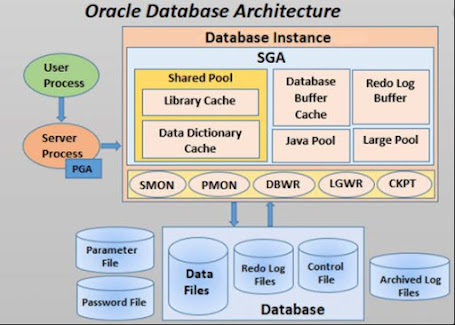Oracle Memory architecture
Oracle database uses several memory structures to manage and optimize database operations. These memory structures are collectively referred to as the System Global Area (SGA) and the Program Global Area (PGA). Here are the main memory structures in Oracle:
System Global Area (SGA):
Database Buffer Cache: The buffer cache holds copies of data blocks read from data files. It reduces disk I/O by caching frequently accessed data in memory, improving query performance.
Redo Log Buffer: The redo log buffer stores changes made to the database before they are written to the redo log files. It ensures that all changes are recorded for recovery and provides high-performance transaction logging.
Shared Pool: The shared pool consists of the Library Cache and the Data Dictionary Cache. The Library Cache stores SQL statements, execution plans, and other shared SQL and PL/SQL code. The Data Dictionary Cache stores information about database objects, user privileges, and other metadata.
Large Pool: The large pool is an optional memory area used for large-scale allocations and I/O buffers for backup and restore operations, parallel execution, and session memory.
Java Pool: The Java pool stores Java objects and bytecode for Java stored procedures and other Java-related operations.
Streams Pool: The Streams pool is used by Oracle Streams, a feature for data replication and messaging. It stores buffered messages and other Streams-related data.
Program Global Area (PGA):
Stack Space: The stack space is allocated for each session or process in the database. It contains session-specific data, including variables, parameters, and cursor state information.
Private SQL Area: The private SQL area stores information specific to each SQL statement being executed, such as bind variables, query execution plans, and runtime buffers.
Sorting Area: The sorting area is used for sorting operations, such as ORDER BY and GROUP BY clauses. It stores temporary data during sorting operations.
Session Memory: Session memory includes various session-specific memory structures, such as session parameters, session cursors, and session-specific work areas.
These memory structures collectively manage and optimize the database's performance and resource utilization. The sizes of these memory areas can be configured and tuned based on the system's requirements and workload characteristics to ensure optimal performance and efficient memory usage in the Oracle database.

No comments:
Post a Comment